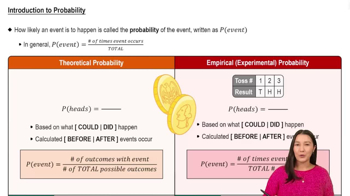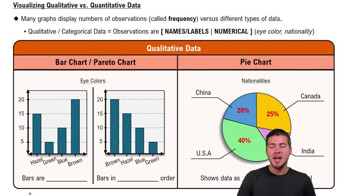A card is drawn from a standard deck of 52 cards. What is the probability that the card is a diamond or a king?
Table of contents
- 1. Intro to Stats and Collecting Data1h 14m
- 2. Describing Data with Tables and Graphs1h 55m
- 3. Describing Data Numerically2h 5m
- 4. Probability2h 16m
- 5. Binomial Distribution & Discrete Random Variables3h 6m
- 6. Normal Distribution and Continuous Random Variables2h 11m
- 7. Sampling Distributions & Confidence Intervals: Mean3h 23m
- Sampling Distribution of the Sample Mean and Central Limit Theorem19m
- Distribution of Sample Mean - Excel23m
- Introduction to Confidence Intervals15m
- Confidence Intervals for Population Mean1h 18m
- Determining the Minimum Sample Size Required12m
- Finding Probabilities and T Critical Values - Excel28m
- Confidence Intervals for Population Means - Excel25m
- 8. Sampling Distributions & Confidence Intervals: Proportion1h 12m
- 9. Hypothesis Testing for One Sample3h 29m
- 10. Hypothesis Testing for Two Samples4h 50m
- Two Proportions1h 13m
- Two Proportions Hypothesis Test - Excel28m
- Two Means - Unknown, Unequal Variance1h 3m
- Two Means - Unknown Variances Hypothesis Test - Excel12m
- Two Means - Unknown, Equal Variance15m
- Two Means - Unknown, Equal Variances Hypothesis Test - Excel9m
- Two Means - Known Variance12m
- Two Means - Sigma Known Hypothesis Test - Excel21m
- Two Means - Matched Pairs (Dependent Samples)42m
- Matched Pairs Hypothesis Test - Excel12m
- 11. Correlation1h 6m
- 12. Regression1h 50m
- 13. Chi-Square Tests & Goodness of Fit1h 57m
- 14. ANOVA1h 57m
4. Probability
Addition Rule
Problem 4.RE.4
Textbook Question
In Exercises 1–10, use the data in the accompanying table and express all results in decimal form. (The data are from “The Left-Handed: Their Sinister History,” by Elaine Fowler Costas, Education Resources Information Center, Paper 399519.)

Lefty or Female Find the probability of randomly selecting one of the study subjects and getting someone who writes with their left hand or is a female.
 Verified step by step guidance
Verified step by step guidance1
Step 1: Understand the problem. We are tasked with finding the probability of randomly selecting a study subject who either writes with their left hand or is a female. This involves using the formula for the union of two events: P(A or B) = P(A) + P(B) - P(A and B).
Step 2: Calculate the total number of study subjects. Add all the values in the table: Total = 23 (Male Left-Handed) + 217 (Male Right-Handed) + 65 (Female Left-Handed) + 455 (Female Right-Handed).
Step 3: Calculate P(A), the probability of selecting someone who writes with their left hand. Add the number of left-handed males and females (23 + 65), then divide by the total number of study subjects.
Step 4: Calculate P(B), the probability of selecting someone who is female. Add the number of females (65 + 455), then divide by the total number of study subjects.
Step 5: Calculate P(A and B), the probability of selecting someone who is both female and writes with their left hand. This is simply the number of left-handed females (65) divided by the total number of study subjects. Finally, use the formula P(A or B) = P(A) + P(B) - P(A and B) to find the desired probability.
 Verified video answer for a similar problem:
Verified video answer for a similar problem:This video solution was recommended by our tutors as helpful for the problem above
Video duration:
3mPlay a video:
Was this helpful?
Key Concepts
Here are the essential concepts you must grasp in order to answer the question correctly.
Probability
Probability is a measure of the likelihood that a particular event will occur, expressed as a number between 0 and 1. In this context, it involves calculating the chance of randomly selecting a subject who either writes with their left hand or is female. The formula for probability is the number of favorable outcomes divided by the total number of possible outcomes.
Recommended video:

Introduction to Probability
Union of Events
The union of events refers to the occurrence of at least one of two or more events. In this question, we are interested in the union of two events: selecting someone who writes with their left hand and selecting a female. The probability of the union can be calculated using the formula P(A or B) = P(A) + P(B) - P(A and B), where A and B are the two events.
Recommended video:

Probability of Multiple Independent Events
Data Representation
Data representation involves organizing and displaying data in a way that makes it easy to analyze and interpret. In this case, the data is presented in a contingency table that categorizes subjects based on gender and whether they write with their left hand. Understanding how to read and interpret this table is crucial for calculating the required probabilities.
Recommended video:
Guided course

Visualizing Qualitative vs. Quantitative Data

 5:14m
5:14mWatch next
Master Probability of Mutually Exclusive Events with a bite sized video explanation from Patrick
Start learningRelated Videos
Related Practice
Multiple Choice
